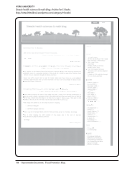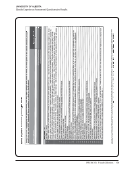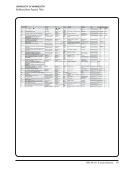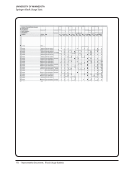SPEC Kit 313: E-book Collections · 67
Challenge 1 Challenge 2 Challenge 3
Cost: mark up by some publishers or
platforms for electronic over print-
associated fees like maintenance,
platform, processing. Some titles are
only available in bundles -rather than
just paying for what we want we end up
(or could end up) paying for less needed
titles to gain access to some or a few
highly needed titles.
Multiple workflows: in general due to
e-books and specifically due to multiple
lending or purchasing models. Questions
on handling packages (treated more
like databases) and ala carte purchases
handled by monographs dept. That
somehow now may need to grapple
with licensing.
Lending outside our campus: since such
a large number of vendors and publishes
prohibit lending of e-texts, this makes
it difficult for consortia that wish to
purchase only one “copy of record” to
be shared by a few of the members (as
we often do for print). Subsequently, the
more we purchase in e-book over print,
the less we have to offer to our other
institutional partners. And, consortial
purchasing options are of course not
available for every platform/vendor.
Cost. Aggregations are expensive,
budgets are decreasing. Title-by-title
costs are higher than print, so it is not
a completely neutral decision, more
electronic means relatively fewer titles
purchased.
Platform diversity. We must have dozens
of e-book platforms and interfaces. Very
difficult to instruct patrons on how to
use all of them.
Perpetual access guarantees. We
have yet to see those tested, though
CLOCKSS and Portico seem to be
growing options that are well trusted.
Different platforms and features/abilities
of each, such as the ability to download,
print, and navigate through a title
Technology for e-books is still lagging
behind the rest of the world
Workflow is difficult to manage
Difficult to get interlibrary loan rights. No standardization among delivery
platforms.
Need for a non-proprietary high quality
reader.
Discovery: Cataloging some materials,
particularly e-standing orders, can be
challenging without a physical item, it
is hard to know when a new volume is
available.
Duplication: Selection of e-format over
print is a hard decision, and we have
seen duplication across formats.
Delivery: Should we focus our
purchasing on one platform/vendor
to provide users with a consistent
experience? What is the best platform to
deliver our e-book content?
Dismantling monolithic print operations
--how do we change print operations
to accommodate e-models from soup to
nuts. What do we do with the approval
plan? How do we convert print money
to e-money? How do we find the extra
money for the e-versions of books when
so much money is tied up in serials?
Too many crazy purchasing models.
Publishers who don’t understand the
realities of monographic purchasing, nor
library budget realities. Librarians with
poor understanding of licensing and
copyright.
Similar to the challenges of e-resources
in general, we need new ways for
providing access to this content, better
search and discoverability methods.
DRM Business Model/Archiving Librarian acceptance
DRM is a constant problem. Printing Our users have been accepting of
e-books, but not all of our librarians
have been.
Challenge 1 Challenge 2 Challenge 3
Cost: mark up by some publishers or
platforms for electronic over print-
associated fees like maintenance,
platform, processing. Some titles are
only available in bundles -rather than
just paying for what we want we end up
(or could end up) paying for less needed
titles to gain access to some or a few
highly needed titles.
Multiple workflows: in general due to
e-books and specifically due to multiple
lending or purchasing models. Questions
on handling packages (treated more
like databases) and ala carte purchases
handled by monographs dept. That
somehow now may need to grapple
with licensing.
Lending outside our campus: since such
a large number of vendors and publishes
prohibit lending of e-texts, this makes
it difficult for consortia that wish to
purchase only one “copy of record” to
be shared by a few of the members (as
we often do for print). Subsequently, the
more we purchase in e-book over print,
the less we have to offer to our other
institutional partners. And, consortial
purchasing options are of course not
available for every platform/vendor.
Cost. Aggregations are expensive,
budgets are decreasing. Title-by-title
costs are higher than print, so it is not
a completely neutral decision, more
electronic means relatively fewer titles
purchased.
Platform diversity. We must have dozens
of e-book platforms and interfaces. Very
difficult to instruct patrons on how to
use all of them.
Perpetual access guarantees. We
have yet to see those tested, though
CLOCKSS and Portico seem to be
growing options that are well trusted.
Different platforms and features/abilities
of each, such as the ability to download,
print, and navigate through a title
Technology for e-books is still lagging
behind the rest of the world
Workflow is difficult to manage
Difficult to get interlibrary loan rights. No standardization among delivery
platforms.
Need for a non-proprietary high quality
reader.
Discovery: Cataloging some materials,
particularly e-standing orders, can be
challenging without a physical item, it
is hard to know when a new volume is
available.
Duplication: Selection of e-format over
print is a hard decision, and we have
seen duplication across formats.
Delivery: Should we focus our
purchasing on one platform/vendor
to provide users with a consistent
experience? What is the best platform to
deliver our e-book content?
Dismantling monolithic print operations
--how do we change print operations
to accommodate e-models from soup to
nuts. What do we do with the approval
plan? How do we convert print money
to e-money? How do we find the extra
money for the e-versions of books when
so much money is tied up in serials?
Too many crazy purchasing models.
Publishers who don’t understand the
realities of monographic purchasing, nor
library budget realities. Librarians with
poor understanding of licensing and
copyright.
Similar to the challenges of e-resources
in general, we need new ways for
providing access to this content, better
search and discoverability methods.
DRM Business Model/Archiving Librarian acceptance
DRM is a constant problem. Printing Our users have been accepting of
e-books, but not all of our librarians
have been.
























































































































































































